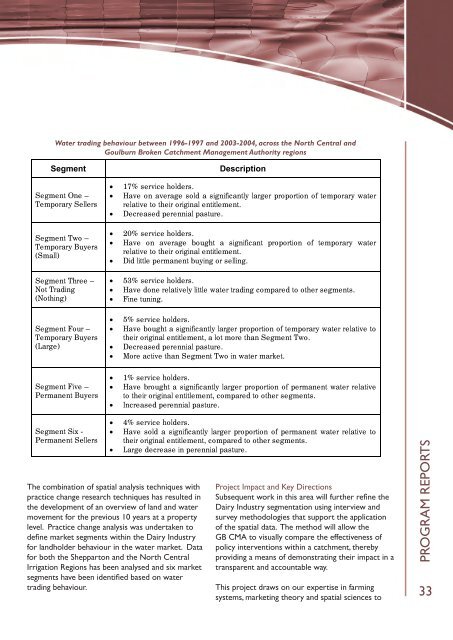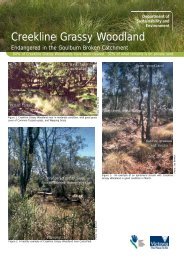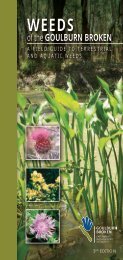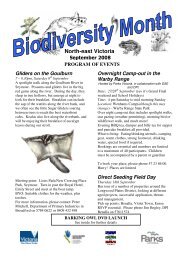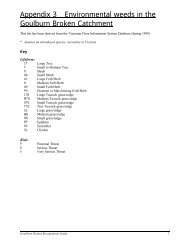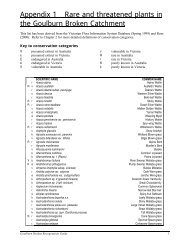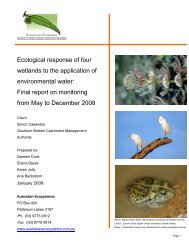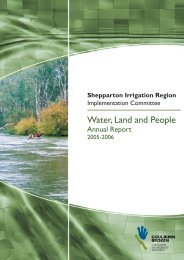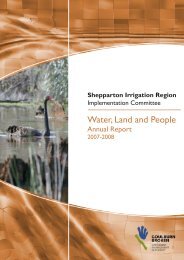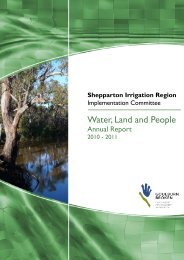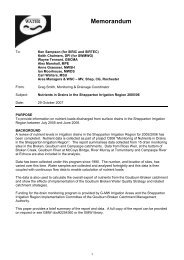Water, Land and People - Goulburn Broken Catchment ...
Water, Land and People - Goulburn Broken Catchment ...
Water, Land and People - Goulburn Broken Catchment ...
You also want an ePaper? Increase the reach of your titles
YUMPU automatically turns print PDFs into web optimized ePapers that Google loves.
<strong>Water</strong> trading behaviour between 1996-1997 <strong>and</strong> 2003-2004, across the North Central <strong>and</strong><br />
<strong>Goulburn</strong> <strong>Broken</strong> <strong>Catchment</strong> Management Authority regions<br />
Segment Description<br />
Segment One –<br />
Temporary Sellers<br />
Segment Two –<br />
Temporary Buyers<br />
(Small)<br />
Segment Three –<br />
Not Trading<br />
(Nothing)<br />
Segment Four –<br />
Temporary Buyers<br />
(Large)<br />
Segment Five –<br />
Permanent Buyers<br />
Segment Six -<br />
Permanent Sellers<br />
� 17% service holders.<br />
� Have on average sold a significantly larger proportion of temporary water<br />
relative to their original entitlement.<br />
� Decreased perennial pasture.<br />
� 20% service holders.<br />
� Have on average bought a significant proportion of temporary water<br />
relative to their original entitlement.<br />
� Did little permanent buying or selling.<br />
� 53% service holders.<br />
� Have done relatively little water trading compared to other segments.<br />
� Fine tuning.<br />
� 5% service holders.<br />
� Have bought a significantly larger proportion of temporary water relative to<br />
their original entitlement, a lot more than Segment Two.<br />
� Decreased perennial pasture.<br />
� More active than Segment Two in water market.<br />
� 1% service holders.<br />
� Have brought a significantly larger proportion of permanent water relative<br />
to their original entitlement, compared to other segments.<br />
� Increased perennial pasture.<br />
� 4% service holders.<br />
� Have sold a significantly larger proportion of permanent water relative to<br />
their original entitlement, compared to other segments.<br />
� Large decrease in perennial pasture.<br />
Project Impact <strong>and</strong> Key Directions<br />
Subsequent work in this area will further refine the Dairy Industry segmentation using<br />
The<br />
interview<br />
combination<br />
<strong>and</strong><br />
of<br />
survey<br />
spatial<br />
methodologies<br />
analysis techniques<br />
that<br />
with<br />
support<br />
Project<br />
the application<br />
Impact <strong>and</strong> Key<br />
of the<br />
Directions<br />
spatial data. The<br />
practice<br />
method<br />
change<br />
will allow<br />
research<br />
the<br />
techniques<br />
GB CMA<br />
has<br />
to<br />
resulted<br />
visually<br />
in<br />
compare<br />
Subsequent<br />
the effectiveness<br />
work in this<br />
of<br />
area<br />
policy<br />
will further<br />
interventions<br />
refine the<br />
the within development a catchment, of an overview thereby of providing l<strong>and</strong> <strong>and</strong> a water means of Dairy demonstrating Industry segmentation their impact using in a interview transparent <strong>and</strong><br />
movement <strong>and</strong> accountable for the previous way. 10 years at a property survey methodologies that support the application<br />
level. Practice change analysis was undertaken to of the spatial data. The method will allow the<br />
define This market project segments draws within on our the expertise Dairy Industry in farming GB CMA systems, to visually marketing compare theory the effectiveness <strong>and</strong> spatial of<br />
for sciences l<strong>and</strong>holder to behaviour develop in a the method water that market. can Data be used policy by CMAs interventions to allow within the a spatial catchment, targeting thereby of<br />
for DPI, both DSE the Shepparton <strong>and</strong> CMA <strong>and</strong> investment. the North Central The method will providing allow a CMAs means to of demonstrating visually demonstrate their impact the in a<br />
Irrigation impact Regions of policy has interventions been analysed within <strong>and</strong> six a catchment. market transparent <strong>and</strong> accountable way.<br />
segments have been identified based on water<br />
trading behaviour.<br />
This project draws on our expertise in farming<br />
systems, marketing theory <strong>and</strong> spatial sciences to<br />
Irrigation Futures of the <strong>Goulburn</strong> <strong>Broken</strong> <strong>Catchment</strong><br />
The Project Leader QJ Wang <strong>and</strong> Research Staff Leon Soste (Operational Manager), David<br />
Robertson, Robert Chaffe, <strong>and</strong> Technical Staff Sherridan Watt worked with the DSE<br />
PROGRAM REPORTS<br />
33


